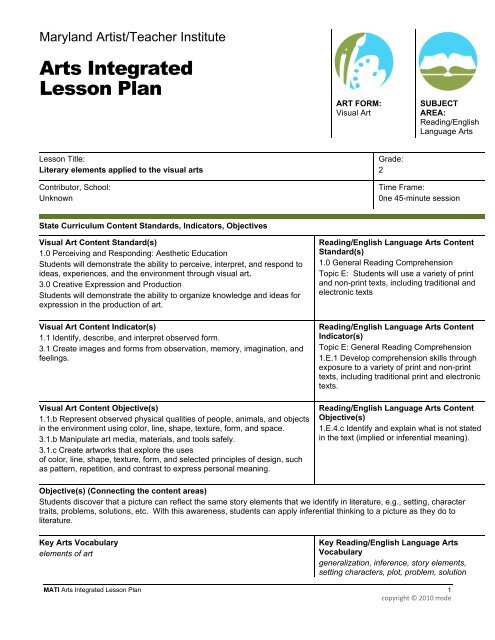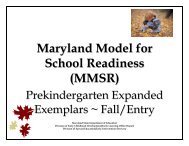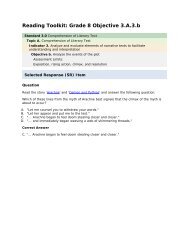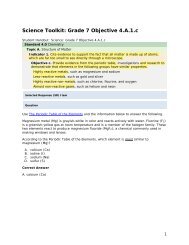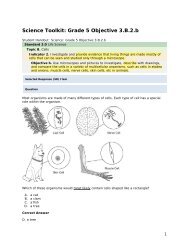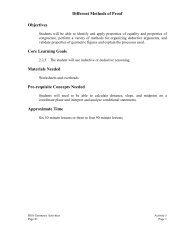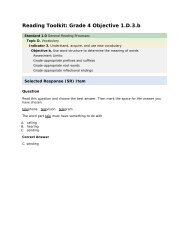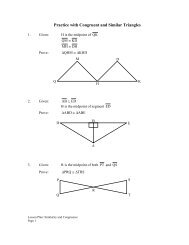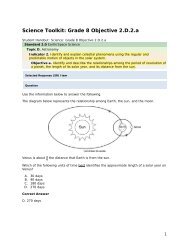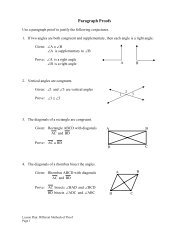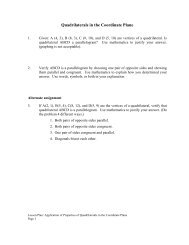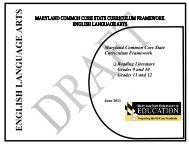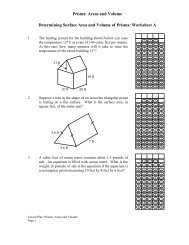Arts Integrated Lesson Plan - mdk12
Arts Integrated Lesson Plan - mdk12
Arts Integrated Lesson Plan - mdk12
Create successful ePaper yourself
Turn your PDF publications into a flip-book with our unique Google optimized e-Paper software.
Maryland Artist/Teacher Institute<br />
<strong>Arts</strong> <strong>Integrated</strong><br />
<strong>Lesson</strong> <strong>Plan</strong><br />
ART FORM:<br />
Visual Art<br />
SUBJECT<br />
AREA:<br />
Reading/English<br />
Language <strong>Arts</strong><br />
<strong>Lesson</strong> Title:<br />
Literary elements applied to the visual arts<br />
Grade:<br />
2<br />
Contributor, School:<br />
Unknown<br />
Time Frame:<br />
0ne 45-minute session<br />
State Curriculum Content Standards, Indicators, Objectives<br />
Visual Art Content Standard(s)<br />
1.0 Perceiving and Responding: Aesthetic Education<br />
Students will demonstrate the ability to perceive, interpret, and respond to<br />
ideas, experiences, and the environment through visual art.<br />
3.0 Creative Expression and Production<br />
Students will demonstrate the ability to organize knowledge and ideas for<br />
expression in the production of art.<br />
Visual Art Content Indicator(s)<br />
1.1 Identify, describe, and interpret observed form.<br />
3.1 Create images and forms from observation, memory, imagination, and<br />
feelings.<br />
Visual Art Content Objective(s)<br />
1.1.b Represent observed physical qualities of people, animals, and objects<br />
in the environment using color, line, shape, texture, form, and space.<br />
3.1.b Manipulate art media, materials, and tools safely.<br />
3.1.c Create artworks that explore the uses<br />
of color, line, shape, texture, form, and selected principles of design, such<br />
as pattern, repetition, and contrast to express personal meaning.<br />
Reading/English Language <strong>Arts</strong> Content<br />
Standard(s)<br />
1.0 General Reading Comprehension<br />
Topic E: Students will use a variety of print<br />
and non-print texts, including traditional and<br />
electronic texts<br />
Reading/English Language <strong>Arts</strong> Content<br />
Indicator(s)<br />
Topic E: General Reading Comprehension<br />
1.E.1 Develop comprehension skills through<br />
exposure to a variety of print and non-print<br />
texts, including traditional print and electronic<br />
texts.<br />
Reading/English Language <strong>Arts</strong> Content<br />
Objective(s)<br />
1.E.4.c Identify and explain what is not stated<br />
in the text (implied or inferential meaning).<br />
Objective(s) (Connecting the content areas)<br />
Students discover that a picture can reflect the same story elements that we identify in literature, e.g., setting, character<br />
traits, problems, solutions, etc. With this awareness, students can apply inferential thinking to a picture as they do to<br />
literature.<br />
Key <strong>Arts</strong> Vocabulary<br />
elements of art<br />
Key Reading/English Language <strong>Arts</strong><br />
Vocabulary<br />
generalization, inference, story elements,<br />
setting characters, plot, problem, solution<br />
MATI <strong>Arts</strong> <strong>Integrated</strong> <strong>Lesson</strong> <strong>Plan</strong> 1<br />
copyright © 2010 msde
Prior Knowledge Students Need for This <strong>Lesson</strong><br />
<strong>Arts</strong><br />
• Students are aware that a picture can tell a story.<br />
Reading/English Language <strong>Arts</strong><br />
• Familiarity with the elements of a<br />
story<br />
• Familiarity with inferential thinking<br />
and making generalizations<br />
Materials and Resources<br />
Materials and Resources for the Class<br />
• Pencils<br />
Materials and Resources for the Teacher<br />
• Prints of artwork that are rich in<br />
visual depictions of story elements<br />
• Teacher-created worksheet<br />
• Captions added for each painting<br />
• Houghton Mifflen Maryland<br />
Teacher’s Edition Theme 35: Focus<br />
on Biography for creation of captions<br />
<strong>Lesson</strong> Development/Procedures (including motivation, modeling, guided practice, and independent practice)<br />
• The teacher reviews the elements of a story with the class.<br />
• The teacher reviews inferences and generalizations with the class.<br />
• Oral examples of inferences and generalizations are cited. Johnny is home in bed with 102 degree fever. Inference:<br />
Johnny is sick. Generalization: People who have fevers are sick.<br />
• Selected artwork is shown to the whole group of students. Students are asked to interpret the story told by images<br />
in the artwork.<br />
• Students apply the elements of a story to the interpretation of the artwork.<br />
• Students make inferences based on the artwork.<br />
• Students make generalizations from the inferences.<br />
• After reading the matching captions, students will revise inferences and generalizations of the artwork.<br />
• Students will then work collaboratively in small groups to create inferences and generalizations about an assigned<br />
piece of artwork.<br />
__________________________________________________________________________________________________<br />
Closure/Summary<br />
Students will reflect on their application of the elements of a story to specific artwork. Students will reflect on the process of<br />
extracting inference and generalization from the artwork.<br />
Assessment (Description/Tools)<br />
Students will demonstrate understanding by completing a teacher-made worksheet with their partners. The worksheet will<br />
include story elements, inferences, and generalizations based on their artwork.<br />
<strong>Lesson</strong> Extensions<br />
Story elements, inferential thinking, and generalizations will be applied to future interpretations of artwork.<br />
MATI <strong>Arts</strong> <strong>Integrated</strong> <strong>Lesson</strong> <strong>Plan</strong> 2<br />
copyright © 2010 msde
MATI <strong>Arts</strong> <strong>Integrated</strong> <strong>Lesson</strong> <strong>Plan</strong> 3<br />
copyright © 2010 msde


